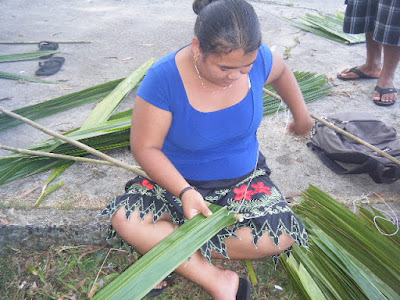Thatching
The SC/SS 115 Ethnobotany class taught each other thatching. In past terms the class used Nipa fruticans. Nipa fruticans can be obtained non-destructively from the plant.
This term the class used the traditional material for Pohnpeian thatching, oahs, (Metroxylon amicarum). Often the harvesting of oahs is done by cutting down the tree due to the extreme height of the mature leaves. This term the supplier was able to harvest leaves from a young oahs without cutting down the tree.
Edelynn starting her thatching.
Strick getting started.
There are two styles of Pohnpeian thatching, doakoahs en Ruk and doakoahs en Pohnpei or simply doakoahs. Doak means "to pierce" with a needle-like object. Oahs is the Pohnpeian name for Metroxylon amicarum.
Rafaila working on doakoahs en Pohnpei.
On Pohnpei in the past the tip of a marlin (a bill fish) was used as a needle. Today the sharpened end of a toothbrush with a hole in the end is a good needle, nails are also sometimes used. Nails with heads, however, do more damage to the frondlet due to their heads.
Amilain.
Today some students carved "needles" from bamboo. One student noted that up in the forest ketieu is preferred (Ixora casei). Another used a short shaft of Acacia auriculiformis. Ultimately whatever material is hard and handy is used.
Glory working on what appears to be doakoahs en Ruk.
Craftsmanship and skill are shown in the even spacing of the stitches and the tightness of the weave. String is not typically used to stitch the thatch together. Some use the outer skin of the main petiole on oahs. One student noted she could not work with the string as she was used to using the outer skin of the main petiole on oahs - the fibers are long and stiff enough to function as their own needle. Others weavers unravel rice sacks of woven plastic for "thread". Some students had heard of the use of hand woven coconut rope.
Megan halfway along the rahu.
Frondlets are folded so as to create a one-third, two-thirds split in relation to the length of the frondlet. The base is one-third, the apical end is two-thirds. The minor rafters over which the frondlets are folded are made of either Phragmites karka (Chuuk: Woowo, niwo, Kosraen: loa, Pohnpeian: lirau) or Saccharum spontaneum (Kosraen: ac, Pohnpeian: ahlek). The minor rafters are called rahu in Pohnpeian. Today we used what appeared to be lirau.
Kimberly starting her thatch.Deisleen.
Monaliza working on doakoahs en Pohnpei.
Doakoahs en Pohnpei differs from doakoahs en Ruk in being laid on a 45 degree diagonal. Note that traditionally Pohnpeian thatch was not covered by a net to protect the roof from wind damage.
Elizabeth working on doakoahs en Ruk, Amilain in the background with doakoahs en Pohnpei.
On the flat, outer island atolls in mid-ocean the wind is a more significant source of damage. On Pohnpei rain and subsequent thatch rot are apparently more problematic. Pohnpei thatch is not netted down. The thatch is designed to catch the wind and "fluff" slightly, aiding in drying of the thatch and slowing rot.
Reedwin shows his expertise with a tight, regular weave, evenly spaced leaves.
Removal of the nohk - the back half of the midrib - is necessary when using oahs due to the thick midrib. The oahs frondlet cracks and breaks unless this is done. This is not apparently strictly necessary with parem. The nohk from oahs are then used to make a whisk broom. The oahs in use was from a younger tree, on some the nohk could be removed, on others the nohk could not.
Samantha and SepeBrianna set the leaves down in pairs as per Kosraean practice. Kosraeans, however, use Nipa palm. Kosrae does not have oahs. Kosrae is presently thought to have only four species of palms. Coconut (Cocos nucifera), betel nut (Areca catechu), Ponapea ledermanianna (Kosrae: kitacr, Pohnpei: kedei) , and Nipa fruticans. On Kosrae Nipa fruticans is used for thatch (Kosrae: fahsuc, Pohnpei: parem). Fahsuc is narrower than oahs. Thatching frondlets are laid down in pairs and folded at the midpoint.
Deisleen working on a needle. Many thanks to the maintenance crew, the knives were just sharpened prior to class.
In Chuuk pandanus is used for thatch, as well as coconut palm leaf. Coconut palm leaf has a reputation for a short life span across Micronesia.
Dayne displays a finished thatch piece.
Linguistic note: dok is "pierce" while oahs refers to Metroxylon amicarum. The combining of the words is what is known in linguistics as verb noun incorporation or incorporated objects. When the word is by itself, it is dok (intransitive), which means to pierce or to stab. The transitive form of it on the other hand is doakoa. The use of /oa/ is sometimes /o/, depending on the following vowel or consonant sounds. For instance, doakoahs, to pierce oahs, dokpwihk, literally to stab a pig (to pig-slaughter), dokomwomw, to spearfish,etc. [Source: Robert Andreas]


















Comments
Post a Comment